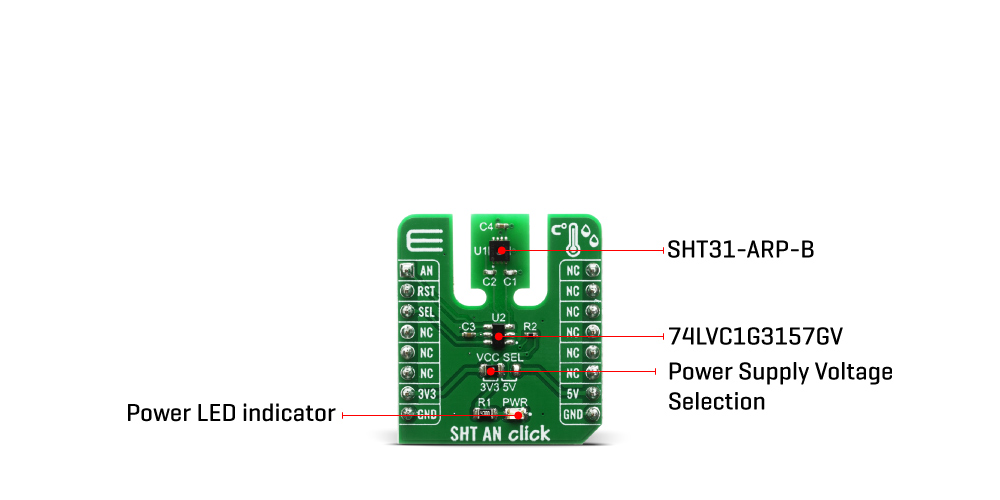






Overview
The SHT AN Click Board™ is a sensory-based add on board that can be used for measuring humidity and temperature. It features a fully calibrated, linearized and temperature compensated SHT31-ARP-B sensor with analog output. This sensor is built on a new technology CMOSens® sensor chip from Sensirion.
What differentiates this Click Board™ board comparing to others is dual-sensor analog output which can be used for measuring and calculation the data over one analog output. This board is best suitable for smart and low power applications which require a temperature range of -40 to up to 90 °C. We have also in our offer SHT Click Board™, which is a digital interface version of the same sensor.
Downloads
How Does The SHT AN Click Board™ Work?
The SHT AN Click Board™ is featuring SHT31-ARP-B that was built on a completely new and optimized CMOSens® chip, which allows for increased reliability and improved accuracy specifications. Sensor can be ordered with filter membrane which is a PTFE film that protects sensor from opening from water and dust.

Since the SHT31-ARP-B is a temperature and humidity (T and RH) sensor with two analog outputs for each measurement, and on the mikroBUS socket we have only one Analog output we multiplexed sensor output by suing 74LVC1G3157GV, 2-channel analog multiplexer/demultiplexer. Switching between temperature and humidity measurements is performed by asserting the selection input (SEL) which is connected to the multiplexer and by that way selecting desired data output.
Measured data is supplied as radiometric voltage output, after reading the temperature or humidity analog signal user will have to do conversion to a physical value. The physical values as measured by the sensor are mapped to a radiometric voltage output (VT, VRH as 10 to 90% of VDD). Prior to conversion into a voltage signal, the physical values are linearized and compensated for temperature and supply voltage effects by the sensor. Additionally, the voltage output is calibrated for each sensor.
The nRST pin is active low and may be used to generate a reset of the sensor. A minimum pulse duration of 1 µs is required to reliably trigger a reset. The nRST signal is routed to the mikroBUS™ RST pin.
The SHT AN Click Board™ can be supplied and interfaced with both 3.3V and 5V without the need for any external components. The onboard SMD jumper labelled as VCC SEL allows voltage selection for interfacing with both 3.3V and 5V microcontrollers.
SPECIFICATIONS
| Type | Temperature & humidity |
| Applications | Industrial RH and temperature measuring applications, smart home, air conditioner, home and environmental monitoring, etc... |
| On-board modules | SHT AN Click uses the SHT31-ARP, a high accuracy temperature and humidity sensor from Sensirion. |
| Key Features | Key Features Low energy consumption, wide temperature and humidity operating range with low RH response time, small package |
| Interface | Analog,GPIO |
| Compatibility | mikroBUS |
| Click board size | S (28.6 x 25.4 mm) |
| Input Voltage | 3.3V or 5V |
PINOUT DIAGRAM
This table shows how the pinout of the SHT AN Click Board™ corresponds to the pinout on the mikroBUS™ socket (the latter shown in the two middle columns).
| Notes | Pin |  |
Pin | Notes | |||
|---|---|---|---|---|---|---|---|
| Analog Output | AN | 1 | AN | PWM | 16 | NC | |
| Sensor Reset | RST | 2 | RST | INT | 15 | NC | |
| Selection of measurement channel | SEL | 3 | CS | RX | 14 | NC | |
| NC | 4 | SCK | TX | 13 | NC | ||
| NC | 5 | MISO | SCL | 12 | NC | ||
| NC | 6 | MOSI | SDA | 11 | NC | ||
| Power Supply | 3.3V | 7 | 3.3V | 5V | 10 | 5V | Power Supply |
| Ground | GND | 8 | GND | GND | 9 | GND | Ground |
ONBOARD SETTINGS AND INDICATORS
| Label | Name | Default | Description |
|---|---|---|---|
| LD1 | PWR | - | Power LED Indicator |
| JP2 | VCC SEL | Left | Power Supply Voltage Selection Jumper: Left position 3.3V, right position 5V |
SHT AN CLICK ELECTRICAL SPECIFICATIONS
| Description | Min | Typ | Max | Unit |
|---|---|---|---|---|
| Supply Voltage | 2.4 | - | 5.5 | V |
| Operating Temperature Range | -40 | - | 125 | °C |
| Temperature accuracy | - | +/- 0.3 | - | °C |
| Humidity accuracy | - | +/- 2.0 | - | %RH |
| General Information | |
|---|---|
Part Number (SKU) |
MIKROE-3984
|
Manufacturer |
|
| Physical and Mechanical | |
Weight |
0.018 kg
|
| Other | |
Country of Origin |
|
HS Code Customs Tariff code
|
|
EAN |
8606018718467
|
Warranty |
|
Frequently Asked Questions
Have a Question?
Be the first to ask a question about this.







